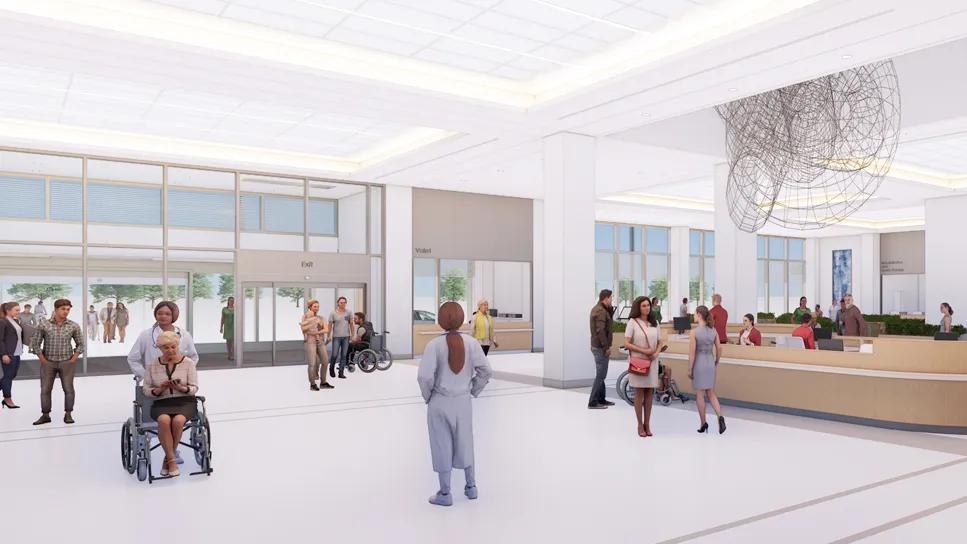Input from these central stakeholders is leading us to design for healing and hope

Cleveland Clinic’s forthcoming Neurological Institute building, slated to open in early 2027 on Cleveland Clinic’s Main Campus (more details here), represents more than just a new physical structure; it embodies a deeply considered approach to both patient and caregiver experience.
Advertisement
Cleveland Clinic is a non-profit academic medical center. Advertising on our site helps support our mission. We do not endorse non-Cleveland Clinic products or services. Policy
From the earliest planning stages, design of the 1 million-square-foot building — which will house ambulatory and inpatient services — has been intentionally shaped by direct input from the very people who will use the space: neurological patients and their families, and the clinicians who care for them. This collaborative philosophy — focused on designing with patients and caregivers rather than merely for them — has been a core principle and guiding light, shaping everything from key architectural elements to the smallest details of interior design.
“As nursing lead for the new building for the past several years, I’ve been intimately involved in the building’s planning, design and now activation,” says Kristen Vargo, DNP, RN, NE-BC, Director of Nursing for Cleveland Clinic’s Neurological Institute. “Our focus has been on integrating current clinical processes into the new environment while enhancing the patient and caregiver experiences. This commitment has required direct engagement, stepping away from theoretical planning to have real conversations with frontline clinicians about their daily work and with our neurological patients about how best to address their priorities.”
A cornerstone of this design process has been the systematic engagement of both the patient community and multidiscliplinary Neurological Institute caregivers.
For patients and families, the Healthcare Partner Council has been instrumental. This dedicated group of approximately 20 volunteers — current or former patients with various neurological conditions, as well as some family members of patients — has been involved since initial conversations about the building’s design began in 2019.
Advertisement
These volunteers have worked closely with Neurological Institute clinicians, the design team and architects to offer specific, patient-centered design suggestions and guidance based on their priorities and lived experiences. Their involvement has included regularly scheduled meetings and structured discussions, along with participation in tours of full-scale mock-ups of both ambulatory and inpatient spaces. These walkthroughs allowed for real-world testing; for example, patients using mobility devices tested the accessibility of bathroom layouts, sink levels, toilets and shower access in the mock-up rooms.
“Our Healthcare Partner Council volunteers are highly engaged and have expressed deep appreciation for being involved early in the design process and feeling truly listened to,” says neurologist Xin Xin Yu, MD, who serves as Patient Experience Officer for the Neurological Institute. “They know they have helped influence design decisions, and they appreciate that they and our clinicians share many design priorities relating to safety, comfort and access.”
Simultaneously, input was actively sought from frontline caregivers across multiple disciplines. “We scheduled town halls with every ambulatory center and inpatient unit,” Vargo explains. “In these meetings, we reviewed detailed floor plans and discussed what mattered most to caregivers in their current practice along with what they wished to see changed in the new building.” The conversations included bedside nurses, respiratory therapists, occupational and physical therapists, and advanced practice providers. “The insights gained were invaluable,” Vargo says, “sometimes prompting minor design adjustments or highlighting processes that would need to be adapted for the new space.”
Advertisement


This input from patients and caregivers has directly shaped plans for the building, impacting everything from patient safety and comfort to caregiver workflow and well-being. Examples are detailed below.
Natural light as a healing element. A fundamental design principle has been maximizing access to natural light from nearly every point in the building. This decision is supported by research highlighting the benefits of such light for both caregivers and patients. Every patient room and floor is designed to incorporate natural light, even deep within the structure. The intent is to support a healing environment, improve emotional well-being and potentially reduce the risk of delirium.
Intuitive wayfinding. Since navigation in a large facility can be stressful, especially for patients with neurological conditions, intuitive wayfinding has been a priority. This includes consistent layouts on each floor, with family lounges placed near elevator banks to reduce disorientation. Artwork will be strategically placed for wayfinding, guiding patients toward key areas. Signage placement and clarity will account for the needs of patients with visual or cognitive challenges and those using wheelchairs who have a lower line of sight. Discussion has even included the reflectiveness and texture of flooring and walls, recognizing potential challenges for patients with visual impairments or neuropathy.
Private inpatient rooms. A significant enhancement is that all inpatient rooms will be private, offering a more restful and personal healing space.
Advertisement
Adjustable room environments. Based on patient feedback, inpatient rooms will feature adjustable lighting to accommodate sensitivities common in neurological patients, such as those with epilepsy or migraine.
Optimized bathroom safety. Patient and caregiver input led to crucial design changes in inpatient bathrooms. An initial design placed plumbing over a back safety rail by the toilet, compromising the rail’s utility. Based on feedback, the plumbing was redesigned to ensure the safety rail was completely accessible for patient use.
Targeted patient lifts. A comprehensive analysis of falls among neurological inpatients revealed that the those with epilepsy had the highest risk of falls, particularly in the bathroom, often during ambulation (which is sometimes encouraged, to induce seizures for assessment purposes). Consequently, every room in the building’s epilepsy monitoring unit will have a ceiling-mounted lift installed to enable safe movement of patients to and from the bathroom and back to bed, even if a seizure occurs. Mobile lifts will be available for all other inpatient rooms as needed. This targeted approach will enhance safety for the most vulnerable patients.
Easy access to therapy. Dedicated physical and occupational therapy spaces are being established on all inpatient units in the new building. These spaces will be conveniently located near patient rooms, eliminating the need for patients to travel between floors or share space with other programs. This convenient access is expected to bolster the recovery process during inpatient stays.
Advertisement
Calming infusion environment. The building’s infusion space will be ringed by greenery on the building’s edge, providing a buffer from outside traffic and allowing patients to look out through large windows at this calming view during infusion sessions.
Dedicated decompression spaces. In recognition of the stress that clinical work can cause, the building will include a dedicated decompression space, or “lavender room,” on every inpatient floor. Spurred by caregiver feedback, these rooms will be relaxing areas caregivers can visit during breaks or before/after shifts to tend to their own well-being with calming music, art supplies, yoga mats, aromatherapy or other restorative interventions.
Optimized visibility and efficiency. The design of inpatient floors will ensure clear sight lines from a nursing station into every patient room. Additionally, touchdown stations with large windows will be placed between every other room, offering a full line of sight into patient rooms. This will allow nurses to complete documentation while maintaining continuous visual observation of their patients, a crucial safety feature for high-risk neurological populations.
Convenient imaging access. A CT scanner will be present on the building’s ICU floor, improving efficiency and patient safety by minimizing transport distance. Similarly, a MEG (magnetoencephalography) scanner will be placed on the floor with the epilepsy monitoring unit for ready imaging of epilepsy patients. Additionally, mobile MRI scanners are being trialed and may be adopted for use in the building.
Enhanced collaboration through consolidation. Currently, the Neurological Institute’s services on Cleveland Clinic’s Main Campus are spread across 10 different buildings. The new plan will bring all these services – ambulatory, inpatient, procedural, infusion, operating rooms – under the roof of a single building. “Our caregivers are excited that this centralization will significantly enhance their ability to collaborate across roles and disciplines, elevating the quality and continuity of our patient care,” Vargo observes.
Integrated ambulatory intake. On the ground floor, a key innovation will be a novel assessment center, where ambulatory care patients will check in digitally and efficiently complete a series of neuroperformance modules as they move through the space. Through use of sensors and other advanced data capture technologies to assess gait and other measures (detailed in this companion article), the center is designed to automatically collect as much data on a patient’s neurological function as possible ahead of their provider visit. In addition to freeing up more time with the provider to discuss treatment planning, the assessment center will make patient intake considerably more efficient for caregivers. “The intent is for the building itself to almost serve as a supplementary caregiver to streamline the intake and pre-visit assessment process,” says Dr. Yu.
The new building will incorporate an abundance of other advanced technologies, including enhanced integration of virtual care and distance health offerings (detailed in this companion article). For instance, all inpatient rooms will be equipped with cameras allowing for 24/7 monitoring with two-way video and audio capabilities. While monitoring will be contingent on patient/family consent, the aim is to enhance virtual care capabilities, potentially including virtual nursing for tasks like admission assessments.
“While we are excited about the technologies the new building makes possible, we are taking great care to ensure that technology will be incorporated into our patients’ experiences in a seamless and humanistic way,” Dr. Yu says, noting that the next Healthcare Partner Council meeting is devoted to this very issue. “All patient-facing technologies must support, rather than detract from, person-centered care.
“This is consistent with our overall vision for the building’s design, which is to instill a sense of hope and healing for patients in whatever ways we can, big or small,” Dr. Yu continues. “We will do this through person-centered technologies when that is appropriate and through more fundamental design features, such as promoting abundant natural light. The guiding principle is to encourage hope and promote healing.”
Advertisement

Structured interventions enhance sleep, safety and caregiver resiliency in high-acuity units

Automating routine medical coding tasks removes unnecessary barriers

Initiative ensures patients leave the hospital with clean, dry clothing

Palliative and Supportive Care Teams offer comprehensive care to improve the lives of patients facing cancer

Leadership role offers a way to improve the entire visit

An unexpected health scare provides a potent reminder of what patients need most from their caregivers

Experts offer hands-on support and education

Today’s research helps illuminate tomorrow’s needs